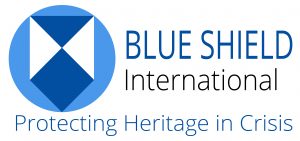Blue Shield International
 The Blue Shield network, often referred to as the cultural equivalent of the Red Cross, was formed in response to the changes in international law and today works globally to protect cultural heritage in emergency situations. They are a non-governmental, non-profit, international organisation committed to the protection of heritage across the world. This includes museums, monuments, archaeological sites, archives, libraries and audio-visual material, and significant natural areas, as well as intangible heritage. The Blue Shield has national committees operating across the world, with more under construction. The national committees are coordinated by an international committee – the Blue Shield International Board.
The Blue Shield network, often referred to as the cultural equivalent of the Red Cross, was formed in response to the changes in international law and today works globally to protect cultural heritage in emergency situations. They are a non-governmental, non-profit, international organisation committed to the protection of heritage across the world. This includes museums, monuments, archaeological sites, archives, libraries and audio-visual material, and significant natural areas, as well as intangible heritage. The Blue Shield has national committees operating across the world, with more under construction. The national committees are coordinated by an international committee – the Blue Shield International Board.
The first international treaties to protect cultural property from the effects of armed conflict date to the 19th century, and have continued to evolve. Following the widespread destruction of cultural heritage during the Second World War, the 1954 Hague Convention for the Protection of Cultural Property in the Event of Armed Conflict was written to create rules to protect cultural property during armed conflicts. This Convention was the first widely adopted international treaty to focus exclusively on the protection of cultural heritage in the context of war, and which highlighted the concept of common heritage. (The first treaty was the Roerich Pact of 1935, but this was never adopted outside the Americas.)
In order to protect endangered cultural heritage, the International Committee of the Blue Shield was created in 1996 by the four non-governmental organisations, which represent professionals active in the fields of archives, libraries, monuments and sites, and museums:
- ICA: International Council on Archives
- ICOM: International Council of Museums
- IFLA: International Federation of Library Associations and Institutions
- ICOMOS: International Council on Monuments and Sites
The four organisations worked together to prepare for, and respond to, emergency situations that could affect cultural heritage. They were joined in 2005 by the CCAAA (Co-ordinating Council of Audiovisual Archives Associations), who later left in 2012. In 2008, the Association of National Committees of the Blue Shield (ANCBS) was established to coordinate the work of the national committees.
They took up the emblem of the 1954 Hague Convention as the symbol of the International Committee of the Blue Shield, in line with Article 17 of the Convention. The distinctive emblem may be used alone only as a means of identification of: (b) the persons responsible for the duties of control in accordance with the Regulations for the execution of the Convention;
By the time the Second Protocol to the Hague Convention was written in 1999, the ICBS was a recognised advisory body to the Inter-Governmental Committee for cultural property protection in armed conflict.
Article 27 Functions
[…] To assist in the implementation of its functions, the Committee may invite to its meetings, in an advisory capacity, eminent professional organizations such as those which have formal relations with UNESCO, including the International Committee of the Blue Shield (ICBS) and its constituent bodies. Representatives of the International Centre for the Study of the Preservation and Restoration of Cultural Property (Rome Centre) (ICCROM) and of the International Committee of the Red Cross (ICRC) may also be invited to attend in an advisory capacity.
In 2016, ICBS and ANCBS amalgamated to become simply “The Blue Shield”.
